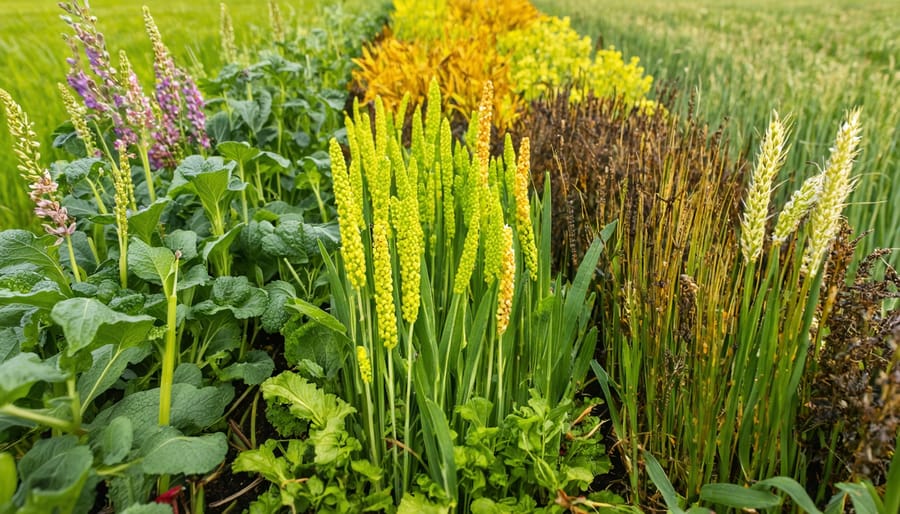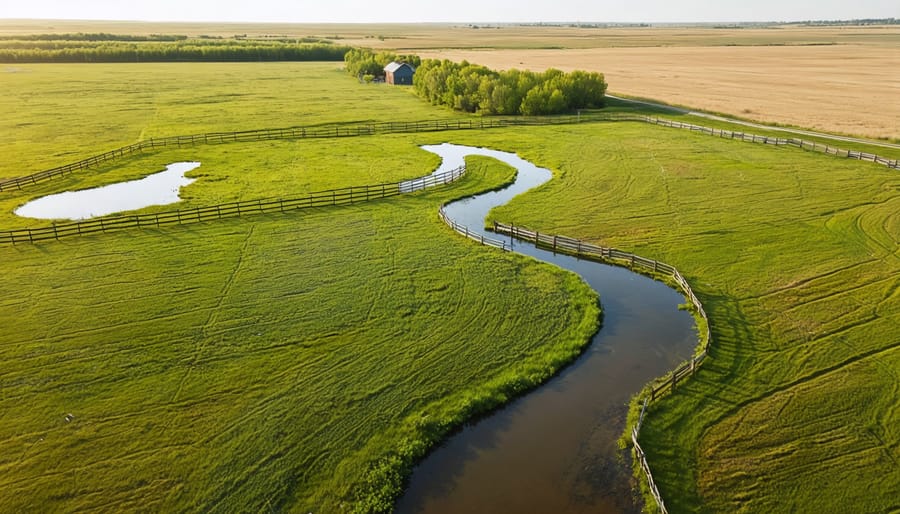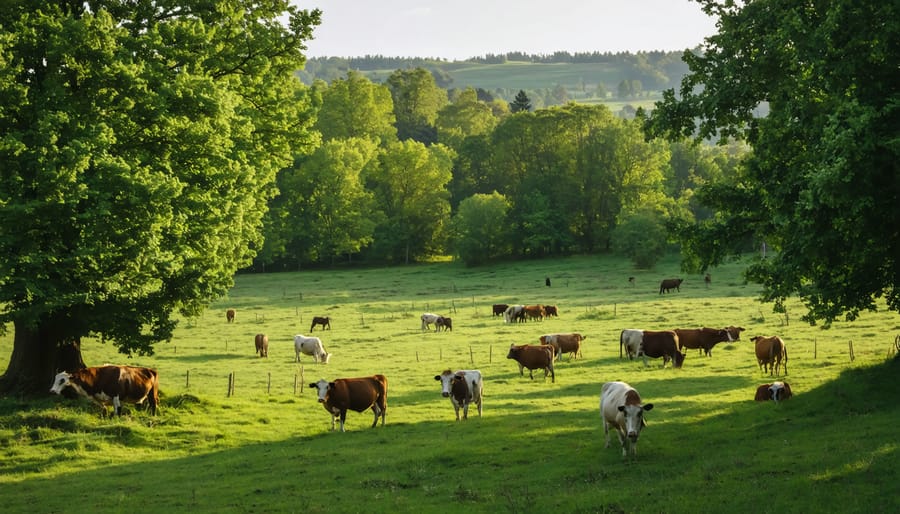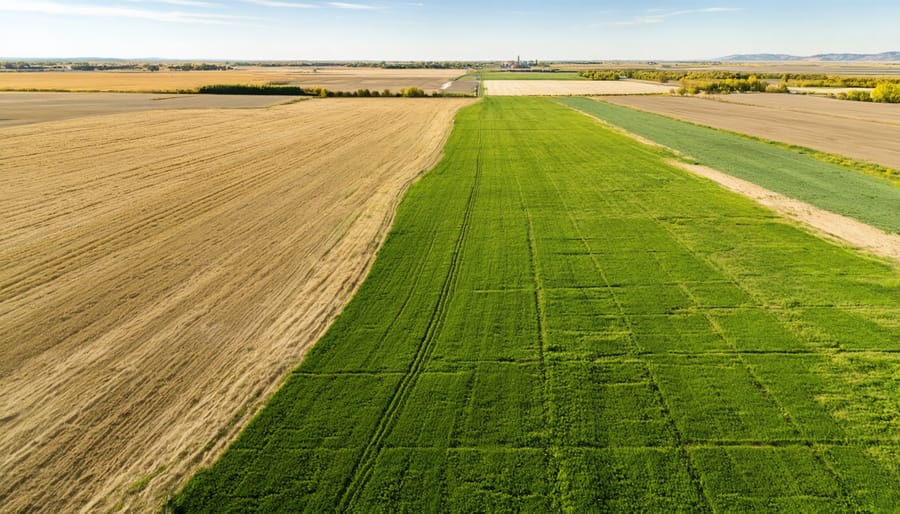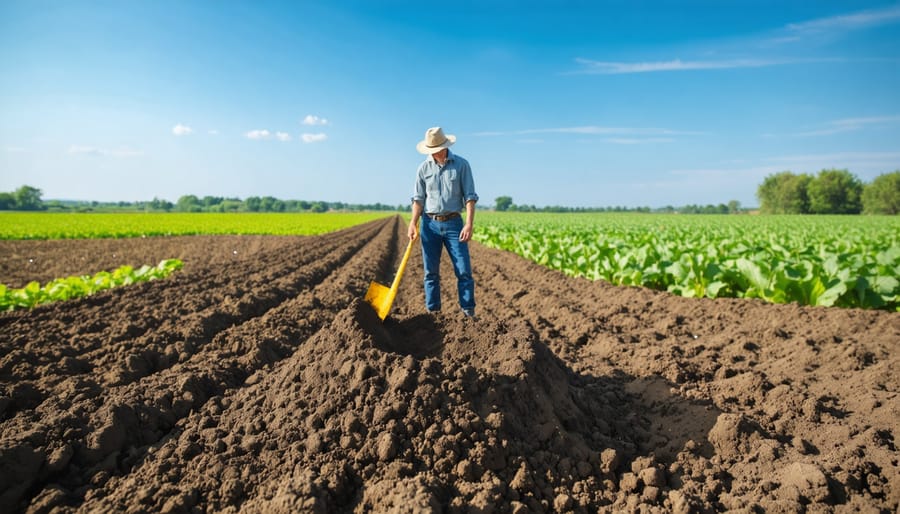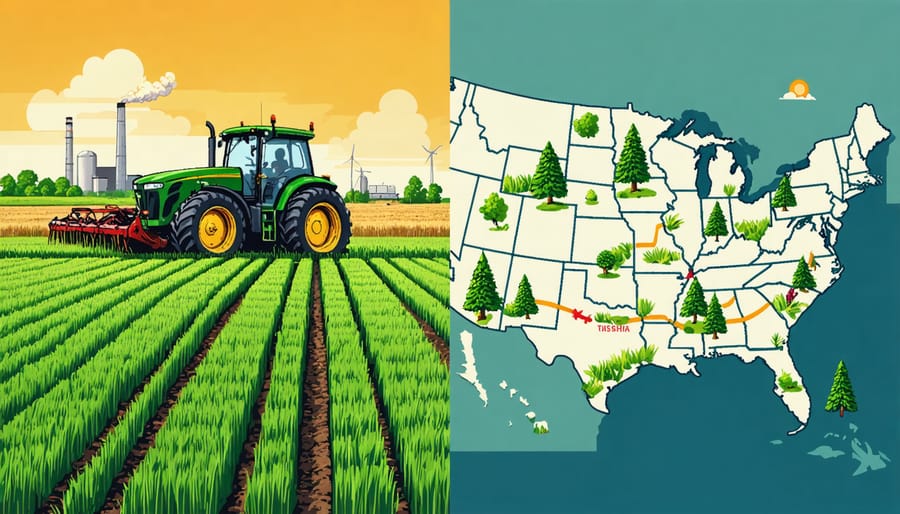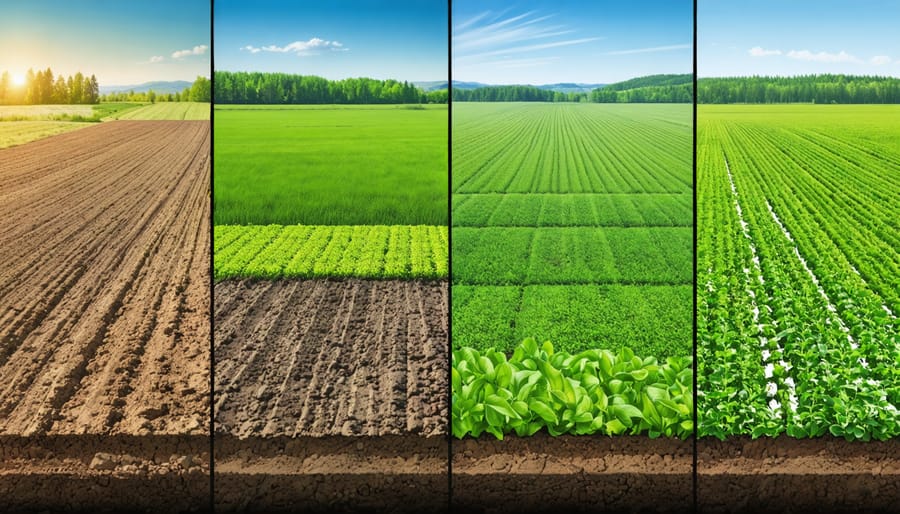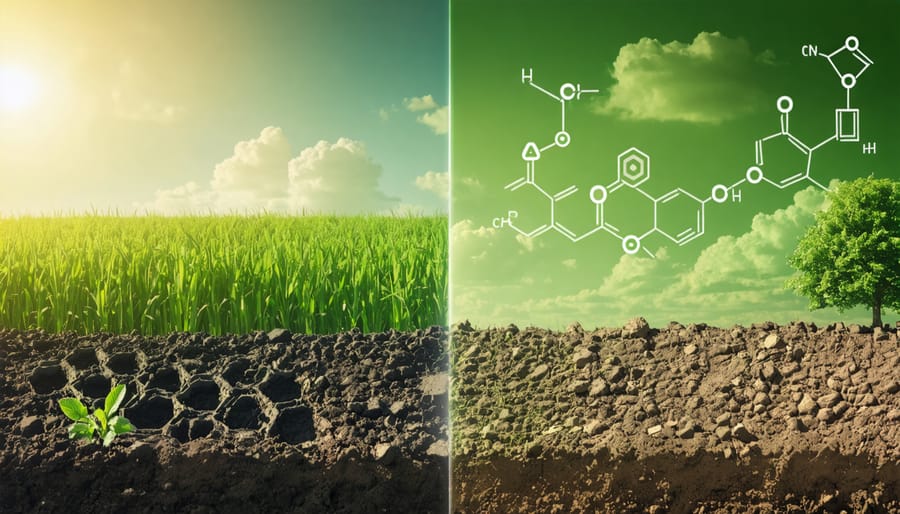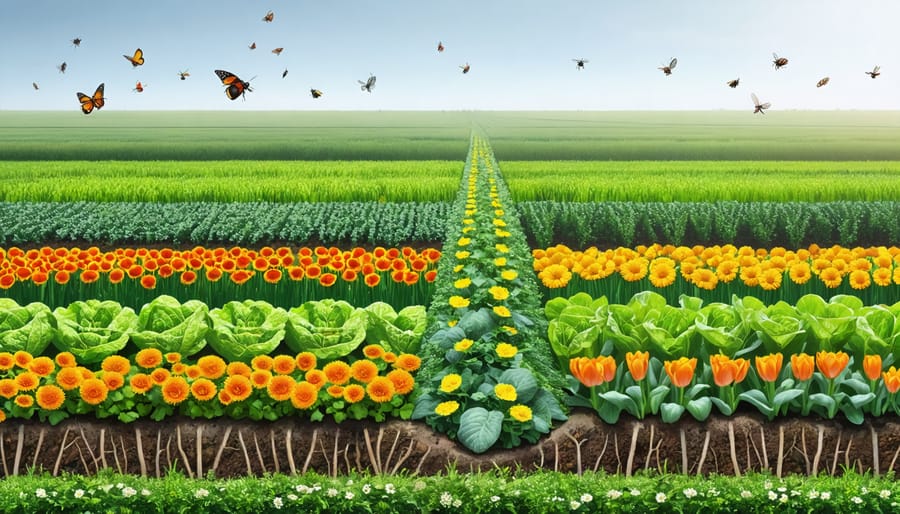Plant diverse cover crop cocktails combining cereals, legumes, and brassicas to maximize carbon sequestration in agriculture while building soil structure. Select winter-hardy varieties like fall rye and hairy vetch that thrive in Alberta’s climate, establishing them immediately after harvest to ensure adequate root development before frost. Integrate cover crops into existing rotations by frost-seeding red clover into standing wheat or broadcasting daikon radish before combining canola. Monitor soil organic matter levels through regular testing to quantify carbon storage benefits, typically seeing 0.1-0.3% increases annually with consistent cover crop use. This regenerative approach not only captures atmospheric carbon but also reduces erosion, improves water retention, and naturally suppresses weeds – delivering multiple benefits while building climate resilience across Prairie farming operations.
How Cover Crops Transform Your Soil’s Carbon Storage
The Underground Carbon Network
Beneath every thriving cover crop lies an intricate network of roots and beneficial fungi working together to store carbon deep within our soil. This underground system is far more complex than what meets the eye above ground. Root systems of cover crops, particularly deep-rooted species like clover and alfalfa, can extend several metres into the soil, creating channels for water infiltration while contributing to soil organic matter development.
These roots partner with mycorrhizal fungi to form vast underground networks, often called the “Wood Wide Web” by Alberta farmers. These fungal networks act like nature’s carbon storage system, transferring carbon compounds from plant roots into stable forms that can remain in the soil for decades. For every tonne of plant biomass above ground, there’s typically 2-3 times that amount of carbon being stored below through root systems and fungal networks.
In our Prairie soils, these networks are particularly effective at carbon sequestration due to our cold winters, which slow down decomposition and help retain carbon longer. By maintaining living roots in the soil through cover cropping, we’re essentially feeding this underground carbon storage system year-round.
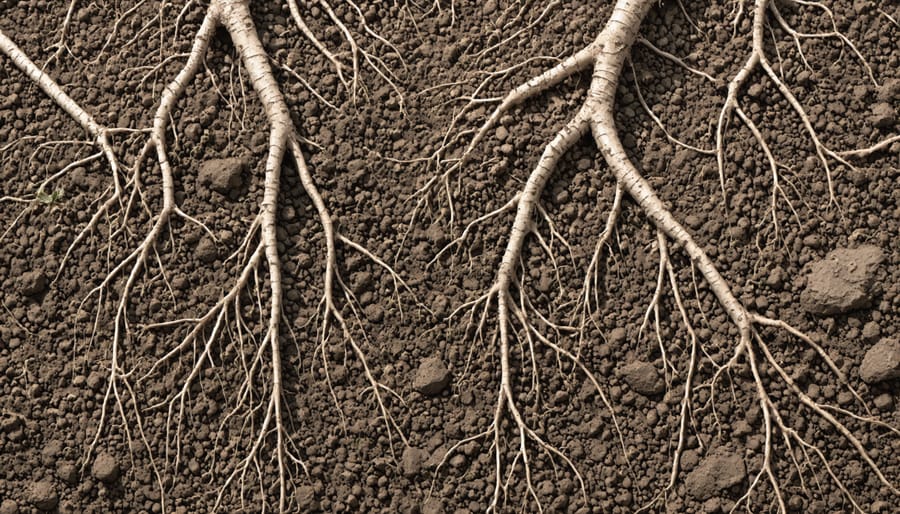
Year-Round Soil Protection
Maintaining year-round soil coverage is a cornerstone of successful regenerative agriculture in Alberta’s diverse climate. When soil remains protected throughout all seasons, it retains significantly more carbon and builds organic matter more effectively than bare soil. This continuous coverage acts like a natural blanket, protecting valuable topsoil from erosion caused by wind and rain while creating a stable environment for beneficial soil microorganisms.
During our harsh prairie winters, covered soil maintains a more consistent temperature and preserves moisture better than exposed ground. Research from Alberta farming communities shows that fields with continuous cover can store up to 30% more soil carbon compared to conventional farming practices. This improved carbon retention not only benefits the environment but also enhances soil structure and water-holding capacity.
Local farmers have reported that maintaining year-round coverage through strategic cover crop rotation has reduced their need for synthetic inputs while improving overall soil health. The key is selecting cover crops that can withstand our regional climate patterns and planning succession planting to ensure there are no gaps in coverage throughout the growing season and into winter.
Best Cover Crops for Alberta’s Growing Conditions
Cold-Hardy Champions
In Alberta’s challenging winter climate, several cover crop species have proven their resilience and effectiveness. Winter rye stands out as the ultimate cold-hardy champion, capable of surviving temperatures as low as -40°C while maintaining active growth during early spring thaws. This cereal crop develops an extensive root system that continues to protect and nurture soil even during dormant periods.
Hairy vetch, another winter survivor, pairs exceptionally well with winter rye in Alberta conditions. This nitrogen-fixing legume can withstand harsh prairie winters when planted in late summer, especially when combined with standing stubble that provides snow cover protection.
Fall-planted winter triticale has gained popularity among Alberta farmers for its dual benefits of erosion control and spring forage potential. This robust hybrid typically emerges before winter sets in and resumes growth earlier than most spring-seeded crops, providing excellent early-season soil protection.
Austrian winter peas have shown promising results in southern Alberta regions, particularly when seeded in areas with reliable snow cover. These peas contribute significant nitrogen to the soil while providing good ground coverage through winter months.
Local success stories include Red Deer County farmer Tom Anderson, who has successfully integrated winter camelina into his rotation. This cold-hardy brassica not only survives Alberta winters but also provides early spring pollinator habitat and valuable soil protection during critical spring melt periods.
For best results in our climate, timing is crucial. Seed winter-hardy cover crops between mid-August and early September to ensure adequate establishment before winter dormancy. Consider your specific soil conditions and typical snow coverage patterns when selecting species for your operation.
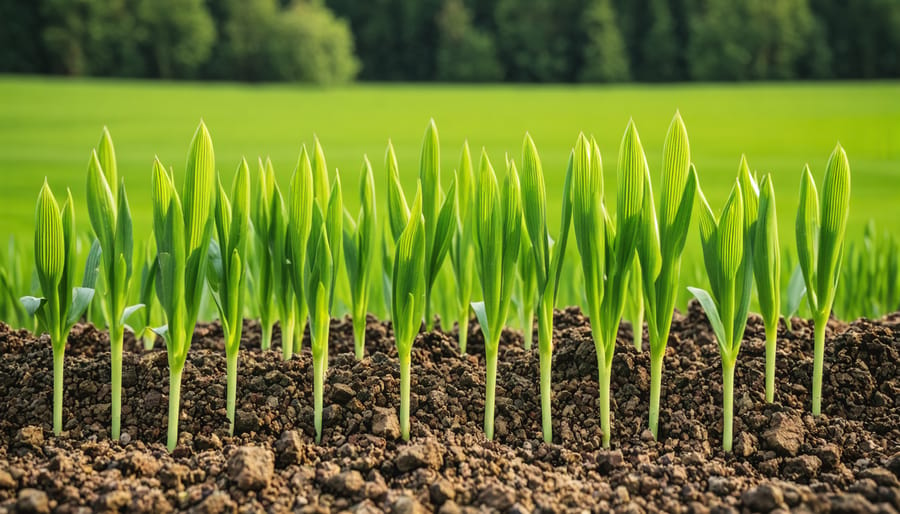
Drought-Resistant Options
In Alberta’s challenging climate, selecting the right drought-resistant cover crops is crucial for successful drought-resistant farming practices. Several hardy species have proven particularly effective in our prairie conditions.
Austrian Winter Peas and Hairy Vetch demonstrate remarkable resilience in low-moisture conditions while providing excellent nitrogen fixation. These legumes develop deep root systems that help maintain soil structure during dry spells and contribute to improved water retention.
Drought-tolerant cereals like Fall Rye and Triticale are excellent choices for our region. These crops establish quickly, provide good ground cover, and their extensive root systems help prevent soil erosion. Many Alberta farmers have found success combining these cereals with legumes for maximum soil benefits.
Safflower and Sunflowers, with their deep taproots reaching up to 2 metres, are becoming increasingly popular choices. These plants access moisture and nutrients from deeper soil layers, creating natural water channels that benefit subsequent crops.
For shorter growing windows, consider Buckwheat or Millet. These fast-growing options require minimal moisture to establish and can provide significant biomass in just 60 days. They’re particularly useful for late-season planting when moisture levels might be depleted.
Before selecting your cover crop mix, consider your specific soil type and typical rainfall patterns. Start with small test plots to determine which combinations work best for your operation. Many successful Alberta farmers maintain flexibility in their cover crop plans, adjusting their species selection based on seasonal moisture forecasts and timing.
Implementation Success Stories
Red Deer Valley Farm’s Carbon Journey
Located just outside of Red Deer, Alberta, the Jensen family farm has become a regional success story in carbon sequestration through cover cropping. In 2018, Mark Jensen and his daughter Sarah began transitioning their 800-hectare operation from traditional farming methods to a regenerative approach, starting with a 40-hectare test plot of fall rye and hairy vetch mixture.
“We were skeptical at first,” admits Mark. “But after seeing the soil improvements in just two seasons, we knew we were onto something special.” Their initial soil tests showed organic matter levels at 2.3%, but after three years of strategic cover cropping, those numbers increased to 3.8%, significantly boosting their carbon storage capacity.
The Jensens now employ a diverse rotation of cover crops, including clover, winter peas, and radish, carefully selected to thrive in Alberta’s climate. Their system maximizes growing days by frost-seeding in early spring and establishing covers immediately after harvest.
The results speak for themselves: water retention has improved by 40%, fertilizer use has decreased by 30%, and soil erosion has virtually disappeared. The farm has documented a carbon sequestration rate of approximately 2.5 tonnes per hectare annually, while maintaining profitable crop yields.
“What’s really exciting,” Sarah notes, “is how other farmers in the area are taking notice. We’ve hosted six field days this year alone, sharing our experiences with neighbors who want to learn more about cover cropping for carbon capture.”
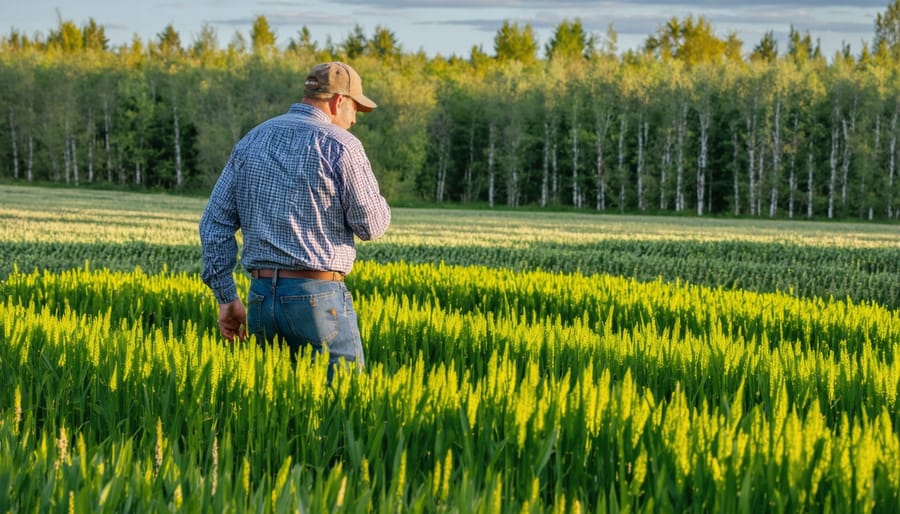
Peace Region’s Multi-Species Approach
In Alberta’s Peace Region, innovative farmers have developed a unique multi-species approach to cover cropping that’s proving successful in the northern climate. Local farmer Sarah Thompson, who farms near Grande Prairie, has pioneered a blend that includes fall rye, hairy vetch, crimson clover, and forage radish – each serving distinct purposes in soil health and carbon sequestration.
“We’ve found that combining these species creates a synergy that works particularly well in our shorter growing season,” Thompson explains. “The fall rye provides quick ground cover and erosion control, while the vetch fixes nitrogen. The radish helps break up compaction, and the clover supports beneficial insects while adding additional nitrogen.”
This combination has shown impressive results, with soil organic matter increasing by 2% over three years on Thompson’s test fields. The mixture also provides excellent winter protection, with the fall rye surviving harsh Alberta winters to continue building soil organic matter in early spring.
Local soil conservation specialist Mike Robertson notes that this blend can be modified based on specific field conditions. For heavier soils, farmers might increase the proportion of radish, while those focusing on nitrogen fixation might add more legumes. The key is maintaining diversity while adapting to local conditions.
Seeding rates typically range from 30-40 kg/ha for this mixture, with costs averaging $75-90 per hectare – an investment that many Peace Region farmers find pays off through improved soil structure and reduced input needs.
Practical Integration Steps
Timing Your Cover Crop Planting
In Alberta’s diverse climate zones, timing your cover crop planting is crucial for achieving successful soil management techniques. For spring planting, aim to seed immediately after your last frost date, typically between late April and early May in southern regions, or mid-May in central and northern areas. This timing allows cover crops to establish before summer heat peaks.
Fall planting windows are equally important, with optimal seeding occurring between early August and mid-September. This gives plants enough time to establish before winter dormancy. For winter-hardy species like fall rye or winter wheat, you can extend planting into late September, but ensure at least 4-6 weeks of growth before the first killing frost.
Consider your main crop rotation when planning. If you’re following canola, seed within 48 hours of harvest to maximize growing days. After cereals, you’ll have more flexibility with timing. For intercropping situations, plant cover crops when your main crop reaches the 5-leaf stage to minimize competition.
Moisture conditions should guide your decisions. In dry years, reduce seeding rates by 20-25% and plant slightly deeper (2-3 cm) to access soil moisture. During wet seasons, maintain standard rates but monitor field conditions to avoid compaction during planting operations.
Keep detailed records of planting dates and outcomes to fine-tune your timing for future seasons. Success often comes from adapting these general guidelines to your specific farm conditions and weather patterns.
Equipment and Resource Requirements
To successfully implement cover crops in your regenerative agriculture system, you’ll need several key pieces of equipment and resources. Start with a reliable seed drill or broadcast seeder for efficient planting. Many Alberta farmers find success with both traditional grain drills adapted for cover crops and specialized seeders designed for varying seed sizes.
Essential field equipment includes a roller crimper for terminating cover crops without herbicides, and a mower or flail mower for managing crop height. You’ll also want access to soil testing equipment or services to monitor your soil health progress, including basic pH meters and penetrometers to measure soil compaction.
For smaller operations, hand tools like broad forks and wheel hoes can be valuable for managing test plots. Consider investing in a good moisture meter to track soil moisture levels, especially crucial in Alberta’s variable climate.
Key resources should include:
– Quality cover crop seeds suited to your region
– Soil testing services
– Record-keeping software or journals
– Weather monitoring tools
– Local agricultural extension services
Many of these resources can be shared through equipment-sharing programs or agricultural cooperatives, making implementation more cost-effective. Connect with your local agricultural association to learn about available resources and potential cost-sharing programs for regenerative agriculture initiatives.
Remember to maintain good relationships with seed suppliers who can provide region-appropriate varieties and offer guidance on new cover crop options suited to Alberta’s growing conditions.
As we’ve explored throughout this article, regenerative agriculture cover crops offer a powerful tool for Canadian farmers to enhance soil health, increase biodiversity, and contribute to climate change mitigation. The success stories from Alberta’s farming community demonstrate that implementing cover crops isn’t just environmentally sound – it’s economically viable too.
Remember that starting small is perfectly acceptable. Consider beginning with a test plot of 5-10 hectares to gain experience and confidence. Connect with local agricultural extension offices and join farmer networks in your area to share experiences and learn from others who are already seeing results with cover crops.
The benefits we’ve discussed – from improved soil structure and water retention to enhanced nutrient cycling and carbon sequestration – make cover crops a worthwhile investment in your farm’s future. As our climate continues to change, these practices become increasingly vital for building resilient agricultural systems.
Take the next step by selecting cover crops that match your specific needs and regional conditions. Reach out to local seed suppliers, consult with agricultural experts, and develop a plan that works for your operation. The transition to regenerative practices doesn’t happen overnight, but every hectare of cover crops planted is a step toward more sustainable Canadian agriculture.
Together, we can build a more resilient and productive farming future for Alberta and beyond. The time to act is now – your soil, your farm, and future generations will thank you for it.

